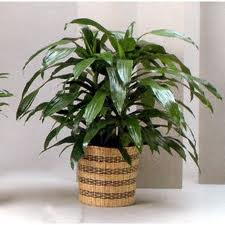 Yes, there are toxins in the air around us, but there’s a simple way to cut down on them — without a HEPA filter. According to the Wall Street Journal, “a growing body of global research is showing plants can reduce dust particles and contaminants, such as formaldehyde and benzene, that come from cigarette smoke, paint, furniture, building materials, and other sources.” What’s more, a recent study cited in the London Daily Mail found that potted plants in offices reduced fatigue, stress, dry throats, headaches, coughs, and dry skin among workers. Which plants are best for keeping you healthy? Here are a few good ones for both desks and bigger spaces — culled from the Wall Street Journal and easywaystogogreen.com
Yes, there are toxins in the air around us, but there’s a simple way to cut down on them — without a HEPA filter. According to the Wall Street Journal, “a growing body of global research is showing plants can reduce dust particles and contaminants, such as formaldehyde and benzene, that come from cigarette smoke, paint, furniture, building materials, and other sources.” What’s more, a recent study cited in the London Daily Mail found that potted plants in offices reduced fatigue, stress, dry throats, headaches, coughs, and dry skin among workers. Which plants are best for keeping you healthy? Here are a few good ones for both desks and bigger spaces — culled from the Wall Street Journal and easywaystogogreen.com
 1. Mother-in-Law’s Tongue – my favorite
1. Mother-in-Law’s Tongue – my favorite
Hardy with tall, blade-shaped leaves, it can tolerate low light and will survive irregular watering. Perfect for black-thumbed couch-potatoes.
 2. Peace Lily
2. Peace Lily
An attractive option with a tropical look, it may droop in bright sun. It’s mildly toxic when ingested, so avoid it if you have curious pets or toddlers.
 3. Janet Craig
3. Janet Craig
Glossy, deep green foliage makes this bushy plant particularly appealing. Look for species from Hawaii, and don’t be tempted to overwater, which can cause leaves to develop brown and yellow spots.
 4. Spider Plant
4. Spider Plant
An easy hanging plant to grow and maintain, this species is named for its long, thin leaves that resemble spider legs. Poisonous to cats.
 5. Fig Tree
5. Fig Tree
The ficus tree can survive for years. Keep it out of direct sunlight and cold drafts, water it, and mist its leaves. Repot every other year.
 6. Rubber Tree
6. Rubber Tree
A spot near a sheer-curtained window with bright, indirect sunlight is ideal for this popular plant. Keep it moist in the growing season.
 7. Boston Fern
7. Boston Fern
For maximum impact, set this long-fronded plant on a pedestal or in a hanging basket in bright, indirect sunlight.
 Large folliage surfaces produce the most oxygen. Grow some fresh air.
Large folliage surfaces produce the most oxygen. Grow some fresh air.
